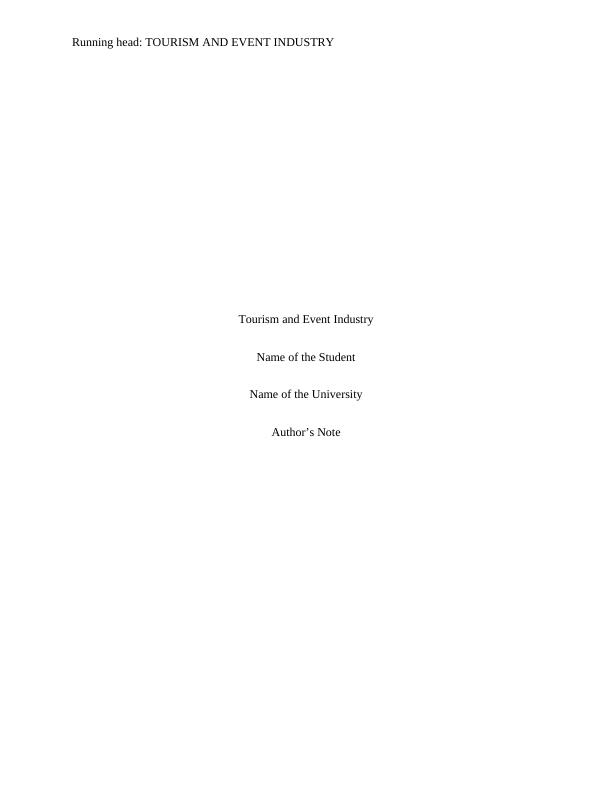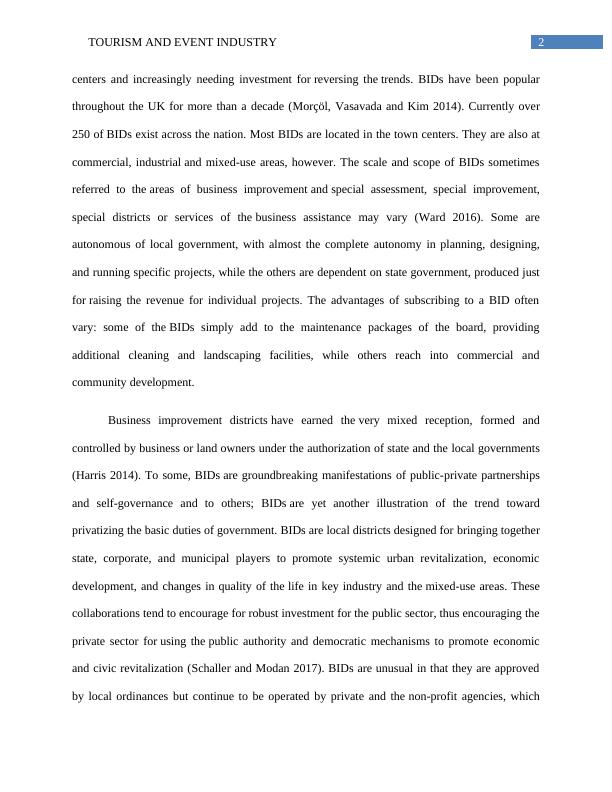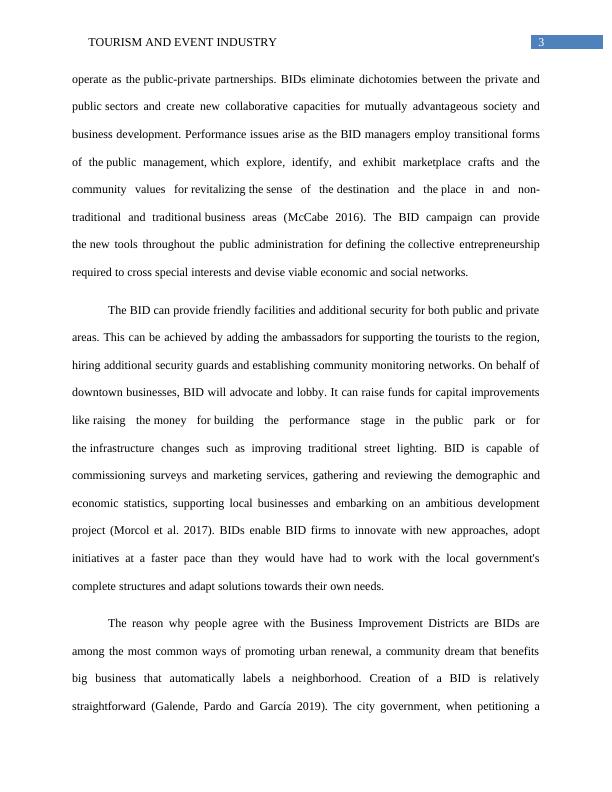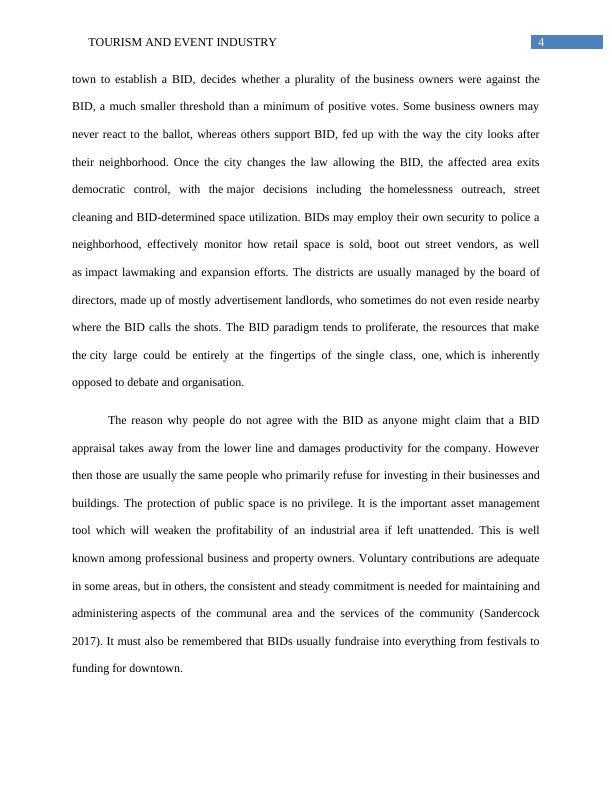Relationship between event and tourism
22 Pages5704 Words32 Views
Added on 2022-08-12
About This Document
Please let me know the cost for 4000 words
Relationship between event and tourism
Added on 2022-08-12
ShareRelated Documents
Running head: TOURISM AND EVENT INDUSTRY
Tourism and Event Industry
Name of the Student
Name of the University
Author’s Note
Tourism and Event Industry
Name of the Student
Name of the University
Author’s Note

1TOURISM AND EVENT INDUSTRY
Introduction
BID (Business Improvement Districts) are associations established in the constitutionally
defined city district from private companies and property owners. Members pay the separate tax
for covering the costs of providing resources to their BID above what the local government is
doing in their area (Morcol et al. 2017). The legalities of creating the BID differ from one state to
other state, but the associations are often formed solely through consent by the majority of
the property owners and local business, by those who own most of the area, or by those who are
responsible for the vast majority of the taxes charged. Historic buildings are crucial to preserving
the history and heritage of the nation. This is also environmentally friendly and practical
recycling, which is essentially large in scale (Silva and Henriques 2015). This cuts down the
requirements for new materials and the other renovation prices. Small changes can be made
for improving the existing structures and meeting the modern architectural standards and
specifications (D'Agostino and Congedo 2014). Innovation in design is certainly essential, but
this is also important to preserve and restore the old structures, because these ancient monuments
are the snapshot of the culture, allowing the people for understanding and respecting people who
lived with various habits and customs of different eras.
PART 1
Evaluation of the Concept of BID
The year 1960 saw the first establishment of BIDs in the US and Canada. Today they live
throughout the world, including in Germany, South Africa, New Zealand, Australia and Japan.
Their origin is in the U.S. sub-urbanization trend, with city centers out-competed as shopping
Introduction
BID (Business Improvement Districts) are associations established in the constitutionally
defined city district from private companies and property owners. Members pay the separate tax
for covering the costs of providing resources to their BID above what the local government is
doing in their area (Morcol et al. 2017). The legalities of creating the BID differ from one state to
other state, but the associations are often formed solely through consent by the majority of
the property owners and local business, by those who own most of the area, or by those who are
responsible for the vast majority of the taxes charged. Historic buildings are crucial to preserving
the history and heritage of the nation. This is also environmentally friendly and practical
recycling, which is essentially large in scale (Silva and Henriques 2015). This cuts down the
requirements for new materials and the other renovation prices. Small changes can be made
for improving the existing structures and meeting the modern architectural standards and
specifications (D'Agostino and Congedo 2014). Innovation in design is certainly essential, but
this is also important to preserve and restore the old structures, because these ancient monuments
are the snapshot of the culture, allowing the people for understanding and respecting people who
lived with various habits and customs of different eras.
PART 1
Evaluation of the Concept of BID
The year 1960 saw the first establishment of BIDs in the US and Canada. Today they live
throughout the world, including in Germany, South Africa, New Zealand, Australia and Japan.
Their origin is in the U.S. sub-urbanization trend, with city centers out-competed as shopping

2TOURISM AND EVENT INDUSTRY
centers and increasingly needing investment for reversing the trends. BIDs have been popular
throughout the UK for more than a decade (Morçöl, Vasavada and Kim 2014). Currently over
250 of BIDs exist across the nation. Most BIDs are located in the town centers. They are also at
commercial, industrial and mixed-use areas, however. The scale and scope of BIDs sometimes
referred to the areas of business improvement and special assessment, special improvement,
special districts or services of the business assistance may vary (Ward 2016). Some are
autonomous of local government, with almost the complete autonomy in planning, designing,
and running specific projects, while the others are dependent on state government, produced just
for raising the revenue for individual projects. The advantages of subscribing to a BID often
vary: some of the BIDs simply add to the maintenance packages of the board, providing
additional cleaning and landscaping facilities, while others reach into commercial and
community development.
Business improvement districts have earned the very mixed reception, formed and
controlled by business or land owners under the authorization of state and the local governments
(Harris 2014). To some, BIDs are groundbreaking manifestations of public-private partnerships
and self-governance and to others; BIDs are yet another illustration of the trend toward
privatizing the basic duties of government. BIDs are local districts designed for bringing together
state, corporate, and municipal players to promote systemic urban revitalization, economic
development, and changes in quality of the life in key industry and the mixed-use areas. These
collaborations tend to encourage for robust investment for the public sector, thus encouraging the
private sector for using the public authority and democratic mechanisms to promote economic
and civic revitalization (Schaller and Modan 2017). BIDs are unusual in that they are approved
by local ordinances but continue to be operated by private and the non-profit agencies, which
centers and increasingly needing investment for reversing the trends. BIDs have been popular
throughout the UK for more than a decade (Morçöl, Vasavada and Kim 2014). Currently over
250 of BIDs exist across the nation. Most BIDs are located in the town centers. They are also at
commercial, industrial and mixed-use areas, however. The scale and scope of BIDs sometimes
referred to the areas of business improvement and special assessment, special improvement,
special districts or services of the business assistance may vary (Ward 2016). Some are
autonomous of local government, with almost the complete autonomy in planning, designing,
and running specific projects, while the others are dependent on state government, produced just
for raising the revenue for individual projects. The advantages of subscribing to a BID often
vary: some of the BIDs simply add to the maintenance packages of the board, providing
additional cleaning and landscaping facilities, while others reach into commercial and
community development.
Business improvement districts have earned the very mixed reception, formed and
controlled by business or land owners under the authorization of state and the local governments
(Harris 2014). To some, BIDs are groundbreaking manifestations of public-private partnerships
and self-governance and to others; BIDs are yet another illustration of the trend toward
privatizing the basic duties of government. BIDs are local districts designed for bringing together
state, corporate, and municipal players to promote systemic urban revitalization, economic
development, and changes in quality of the life in key industry and the mixed-use areas. These
collaborations tend to encourage for robust investment for the public sector, thus encouraging the
private sector for using the public authority and democratic mechanisms to promote economic
and civic revitalization (Schaller and Modan 2017). BIDs are unusual in that they are approved
by local ordinances but continue to be operated by private and the non-profit agencies, which

3TOURISM AND EVENT INDUSTRY
operate as the public-private partnerships. BIDs eliminate dichotomies between the private and
public sectors and create new collaborative capacities for mutually advantageous society and
business development. Performance issues arise as the BID managers employ transitional forms
of the public management, which explore, identify, and exhibit marketplace crafts and the
community values for revitalizing the sense of the destination and the place in and non-
traditional and traditional business areas (McCabe 2016). The BID campaign can provide
the new tools throughout the public administration for defining the collective entrepreneurship
required to cross special interests and devise viable economic and social networks.
The BID can provide friendly facilities and additional security for both public and private
areas. This can be achieved by adding the ambassadors for supporting the tourists to the region,
hiring additional security guards and establishing community monitoring networks. On behalf of
downtown businesses, BID will advocate and lobby. It can raise funds for capital improvements
like raising the money for building the performance stage in the public park or for
the infrastructure changes such as improving traditional street lighting. BID is capable of
commissioning surveys and marketing services, gathering and reviewing the demographic and
economic statistics, supporting local businesses and embarking on an ambitious development
project (Morcol et al. 2017). BIDs enable BID firms to innovate with new approaches, adopt
initiatives at a faster pace than they would have had to work with the local government's
complete structures and adapt solutions towards their own needs.
The reason why people agree with the Business Improvement Districts are BIDs are
among the most common ways of promoting urban renewal, a community dream that benefits
big business that automatically labels a neighborhood. Creation of a BID is relatively
straightforward (Galende, Pardo and García 2019). The city government, when petitioning a
operate as the public-private partnerships. BIDs eliminate dichotomies between the private and
public sectors and create new collaborative capacities for mutually advantageous society and
business development. Performance issues arise as the BID managers employ transitional forms
of the public management, which explore, identify, and exhibit marketplace crafts and the
community values for revitalizing the sense of the destination and the place in and non-
traditional and traditional business areas (McCabe 2016). The BID campaign can provide
the new tools throughout the public administration for defining the collective entrepreneurship
required to cross special interests and devise viable economic and social networks.
The BID can provide friendly facilities and additional security for both public and private
areas. This can be achieved by adding the ambassadors for supporting the tourists to the region,
hiring additional security guards and establishing community monitoring networks. On behalf of
downtown businesses, BID will advocate and lobby. It can raise funds for capital improvements
like raising the money for building the performance stage in the public park or for
the infrastructure changes such as improving traditional street lighting. BID is capable of
commissioning surveys and marketing services, gathering and reviewing the demographic and
economic statistics, supporting local businesses and embarking on an ambitious development
project (Morcol et al. 2017). BIDs enable BID firms to innovate with new approaches, adopt
initiatives at a faster pace than they would have had to work with the local government's
complete structures and adapt solutions towards their own needs.
The reason why people agree with the Business Improvement Districts are BIDs are
among the most common ways of promoting urban renewal, a community dream that benefits
big business that automatically labels a neighborhood. Creation of a BID is relatively
straightforward (Galende, Pardo and García 2019). The city government, when petitioning a

4TOURISM AND EVENT INDUSTRY
town to establish a BID, decides whether a plurality of the business owners were against the
BID, a much smaller threshold than a minimum of positive votes. Some business owners may
never react to the ballot, whereas others support BID, fed up with the way the city looks after
their neighborhood. Once the city changes the law allowing the BID, the affected area exits
democratic control, with the major decisions including the homelessness outreach, street
cleaning and BID-determined space utilization. BIDs may employ their own security to police a
neighborhood, effectively monitor how retail space is sold, boot out street vendors, as well
as impact lawmaking and expansion efforts. The districts are usually managed by the board of
directors, made up of mostly advertisement landlords, who sometimes do not even reside nearby
where the BID calls the shots. The BID paradigm tends to proliferate, the resources that make
the city large could be entirely at the fingertips of the single class, one, which is inherently
opposed to debate and organisation.
The reason why people do not agree with the BID as anyone might claim that a BID
appraisal takes away from the lower line and damages productivity for the company. However
then those are usually the same people who primarily refuse for investing in their businesses and
buildings. The protection of public space is no privilege. It is the important asset management
tool which will weaken the profitability of an industrial area if left unattended. This is well
known among professional business and property owners. Voluntary contributions are adequate
in some areas, but in others, the consistent and steady commitment is needed for maintaining and
administering aspects of the communal area and the services of the community (Sandercock
2017). It must also be remembered that BIDs usually fundraise into everything from festivals to
funding for downtown.
town to establish a BID, decides whether a plurality of the business owners were against the
BID, a much smaller threshold than a minimum of positive votes. Some business owners may
never react to the ballot, whereas others support BID, fed up with the way the city looks after
their neighborhood. Once the city changes the law allowing the BID, the affected area exits
democratic control, with the major decisions including the homelessness outreach, street
cleaning and BID-determined space utilization. BIDs may employ their own security to police a
neighborhood, effectively monitor how retail space is sold, boot out street vendors, as well
as impact lawmaking and expansion efforts. The districts are usually managed by the board of
directors, made up of mostly advertisement landlords, who sometimes do not even reside nearby
where the BID calls the shots. The BID paradigm tends to proliferate, the resources that make
the city large could be entirely at the fingertips of the single class, one, which is inherently
opposed to debate and organisation.
The reason why people do not agree with the BID as anyone might claim that a BID
appraisal takes away from the lower line and damages productivity for the company. However
then those are usually the same people who primarily refuse for investing in their businesses and
buildings. The protection of public space is no privilege. It is the important asset management
tool which will weaken the profitability of an industrial area if left unattended. This is well
known among professional business and property owners. Voluntary contributions are adequate
in some areas, but in others, the consistent and steady commitment is needed for maintaining and
administering aspects of the communal area and the services of the community (Sandercock
2017). It must also be remembered that BIDs usually fundraise into everything from festivals to
funding for downtown.

5TOURISM AND EVENT INDUSTRY
Impact of BID in Newcastle upon Tyne, UK
Turnouts at BID polls are also important to comment on, not just because the turnout of
25 percent or more is the condition for BID acceptance, but also as it may shed more light on the
degree of BID interest by company inhabitants and their electoral process. BIDs achievements
and failures such as public-private collaborations that mostly concentrate on sanitation,
protection and promotion, financed by a compulsory tax on the selected businesses in the area
since they first formed in England in the year 2004. New Super-BIDs must develop the strategic
systemic plan for their communities (Ward and Cook 2017). Super-BIDs must be about more
than just the crime and grime and work in more of the strategic partnership for shaping the
prosperous high streets of the future. Additional super-BIDs seem like the kind of programs that
the Coalition Government might want under the Localism Act to arise. The Local Government
Act 2002 laid down the structured plans for the creation of BIDS and for its financing through an
improvement in the market tax within the designated areas. BIDS has been described as
cooperation agreements through which the local business sector and the local authorities will
undertake schemes that will support the local community, subject to clear tariff payer agreement
for Newcastle upon Tyne, UK (Shaw 2015). Under such arrangements, ratepayers will decide to
pay the annual fee on their rate card and they would be able in determining in advance how that
money is spent and how much money they are prepared for paying in relation to their rate
charge. Every business ratepayer who is asked for contributing to the BID would be able
in voting on whether the BID is going ahead or not. The Bill includes for the creation of BIDS in
any environment where additional benefits are required by the local business sector to those
offered by the local authority and such sites would be city or town centers, regional shopping
areas, commercial towns, industrial estates and business parks. BIDS can offer a number of
Impact of BID in Newcastle upon Tyne, UK
Turnouts at BID polls are also important to comment on, not just because the turnout of
25 percent or more is the condition for BID acceptance, but also as it may shed more light on the
degree of BID interest by company inhabitants and their electoral process. BIDs achievements
and failures such as public-private collaborations that mostly concentrate on sanitation,
protection and promotion, financed by a compulsory tax on the selected businesses in the area
since they first formed in England in the year 2004. New Super-BIDs must develop the strategic
systemic plan for their communities (Ward and Cook 2017). Super-BIDs must be about more
than just the crime and grime and work in more of the strategic partnership for shaping the
prosperous high streets of the future. Additional super-BIDs seem like the kind of programs that
the Coalition Government might want under the Localism Act to arise. The Local Government
Act 2002 laid down the structured plans for the creation of BIDS and for its financing through an
improvement in the market tax within the designated areas. BIDS has been described as
cooperation agreements through which the local business sector and the local authorities will
undertake schemes that will support the local community, subject to clear tariff payer agreement
for Newcastle upon Tyne, UK (Shaw 2015). Under such arrangements, ratepayers will decide to
pay the annual fee on their rate card and they would be able in determining in advance how that
money is spent and how much money they are prepared for paying in relation to their rate
charge. Every business ratepayer who is asked for contributing to the BID would be able
in voting on whether the BID is going ahead or not. The Bill includes for the creation of BIDS in
any environment where additional benefits are required by the local business sector to those
offered by the local authority and such sites would be city or town centers, regional shopping
areas, commercial towns, industrial estates and business parks. BIDS can offer a number of

End of preview
Want to access all the pages? Upload your documents or become a member.
Related Documents
Report On The Role Of Business Improvement Districts |Tourism Industrylg...
|14
|5041
|223
Strategic Planning for Tourism and Leisure- Doclg...
|17
|5908
|286
Strategic Planning for Tourism and Leisure: Role of BIDs and Historic Buildingslg...
|18
|4643
|68
Commercial Property Development in Central Londonlg...
|12
|3394
|168
Commercial Property Analysis of Sydney CBD Economic Research Assessmentlg...
|18
|4044
|409
Accommodation Services in the Hospitality Industrylg...
|16
|1138
|85
